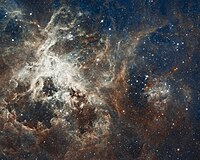NASA's TESS spacecraft reports its first exoplanet
Thursday, September 20, 2018
In findings released to the public on Monday through online site arXiv.org, astronomers reported they have already used data from the first photograph taken by National Aeronautics and Space Administration's (NASA's) Transiting Exoplanet Survey Satellite (TESS) to locate an exoplanet. The planet, called Pi Mensae c, was spotted as it was transiting in front of its star, Pi Mensae (HD 39091). The paper describing the findings was being submitted to AAS Letter but had yet to be published in full.
"Here, we report on the discovery of a transiting planet around [Pi Mensae], exactly the type of planet TESS was designed to detect," states a portion of the paper available to the public.
Scientists say the planet is roughly twice the diameter of Earth but about four times as massive. Findings for Pi Mensae c indicate it may contain helium, methane, hydrogen, and water but is deemed unlikely to support life because it is so close to its star.
TESS, which launched last April, created the light image over the course of 30 minutes on August 7, using four optical telescopes to photograph a small portion of the night sky. Its mission is slated to last two years and reports anticipate it could discover thousands of exoplanets.
This week in an unrelated project, researchers from the University of Florida spotted a planet circling a star named 40 Eriadni A (HD 26965). In the fictional universe of Star Trek, this star system is the home of the Vulcans like Mr. Spock. The exoplanet, officially called HD 26965b, has been nicknamed "Vulcan" after this fictional planet.
Related news
- "NASA launches exoplanet-hunting satellite TESS" — Wikinews, April 21, 2018
Sources
- Avery Thompson. "NASA's New Spacecraft Takes First Photo, Finds First Exoplanet" — Popular Mechanics, September 19, 2018
- George Dvorsky. "NASA's TESS Space Telescope Has Spotted Its First Exoplanet" — Gizmodo, September 19, 2018
- David Freeman. "Astronomers just discovered Spock's home planet, Vulcan" — NBC News, September 19, 2018
- Chelsea X. Huang (MIT), Jennifer Burt, Andrew Vanderburg, Maximilian N. Günther, Avi Shporer, Jason A. Dittmann, Joshua N. Winn, Rob Wittenmyer, Lizhou Sha, Stephen R. Kane, George R. Ricker, Roland Vanderspek, David W. Latham, Sara Seager, Jon Jenkins, Douglas A. Caldwell, Karen A. Collins, Natalia Guerrero, Jeffrey C. Smith, Sam Quinn, Stéphane Udry, Francesco Pepe, François Bouchy, Damien Sé gransan, Christophe Lovis, David Ehrenreich, Maxime Marmier, Michel Mayor, Bill Wohler, Kari Haworth, Edward Morgan, Michael Fausnaugh, David Charbonneau, Norio Narita, the TESS team. "TESS Discovery of a Transiting Super-Earth in the Π Mensae System" — arXiv, September 16, 2018
